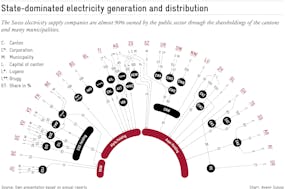What happens now, after Swiss voters rejected the total revision of the country’s CO2 legislation? The various political demands could hardly be more different. But one thing is clear: we cannot sit back and do nothing.
With the Paris Agreement, Switzerland has – along with over 190 other countries – committed to reduce greenhouse gas emissions by at least 50 percent by 2030 versus 1990, setting the course for reaching the net-zero target in 2050. According to provisional data, the target for 2020 (-20 percent compared to 1990) is likely to be missed. Not a good starting point.
Effective climate policy must meet four criteria
After the rejection of the CO2 Act, work on developing an effective alternative must begin urgently. Every new measure should be tested for its long-term performance against transparent criteria. A liberal climate policy must meet these requirements:
1. Effectiveness
Any measure should result in a comprehensive reduction in greenhouse gas emissions. The cut in percentage terms is what counts.
2. Efficiency
The reduction in greenhouse gas emissions per franc invested should be as high as possible. Precisely because cuts are urgent, meeting this criterion is important. Efficiency and effectiveness are linked: if almost no curbs are achieved (effectiveness), the efficiency criterion is difficult to fulfill – unless the measure is very cheap. However, the urgency of climate protection does not justify investing in inadequate measures. This criterion is also relevant because every measure has opportunity costs: Efficiency means minimizing opportunity costs by allocating funds to where they can achieve the most.
3. Cost transparency
The core principle of cost transparency is to enforce the ‘polluter pays’ principle: the emitter of a greenhouse gas should bear both its own costs (zero) and the (future) social costs with respect to the climatic impact of its emissions.
Quantifying the “true” social cost can be difficult – but this is a secondary problem. It is more important to acknowledge that greenhouse gasses generate costs in the first place. The World Bank identified a global price range of $50 -$100 per tonne of CO2eq for 2030 to meet the mitigation pathway for the “below two degrees” Paris climate target.
4. Technology neutrality
The government should only specify a reduction target; the technology should be up to those concerned. This will create open competition between different approaches, with the most efficient and effective prevailing. That does not require a central authority to prejudge which technologies might be best, eliminating the danger of political misjudgments.

Traffic, construction and industry are responsible for 80 percent of the swiss greenhouse gas emissions.
So far, construction and industry have achieved substantial cuts. But transport has been less satisfactory, mainly due to the low legally imposed level of emissions to compensate. The targeted 12 percent for 2021 is too modest to achieve an effective reduction due to the volume growth of transport. The current policy of gradually increasing the compensation rate should be continued.
In agriculture sector, hardly any concrete approaches have been made so far. In fact, there are even misguided incentives, for example refunding fuel tax for agricultural vehicles. Such measures must be eliminated.
The bilateral climate compensation agreements concluded by Bern last year must be continued and extended beyond Peru and Ghana. A memorandum of understanding was recently signed with Thailand. Switzerland is playing a pioneering role here, using an instrument from the Paris Agreement. Reductions financed abroad can be counted towards the country’s own target, insofar as they are real, verifiable and permanent.
The leverage effect of an effective Swiss climate policy
But why all this effort? Some may ask how Swiss policies can have any significant impact when the country’s share of global greenhouse gas emissions is just one per mille.
Mathematically, this objection stands. But it is not very legitimate. Precisely such thinking has contributed to the fact that worldwide progress on the (global) CO2 problem has not been nearly as great as on various other environmental issues with more local effects. Given the admission that climate change is real and fundamental, Switzerland, as one of the wealthiest countries in the world, must contribute.
To achieve the ambitious reduction targets, Switzerland must focus on measures leading to long-term, sustainable cuts while still being affordable. Climate policy must be made more effective by using market-based climate protection instruments. Social acceptance can be increased by redistributing the levies generated to the population on a per capita basis. This places a the net burden on excessive emitters and rewards those pursuing a climate-friendly lifestyle. The redistribution already taking place today – only partially and through the reduction of health insurance premiums – is not tangible enough.
A Swiss climate policy designed to be effective, affordable and socially accepted can be a blueprint for other countries. The leverage effect would be huge and could significantly exceed our own climate impact. So, let’s go ahead.
Further information can be found in our paper “Effective climate policy”.





